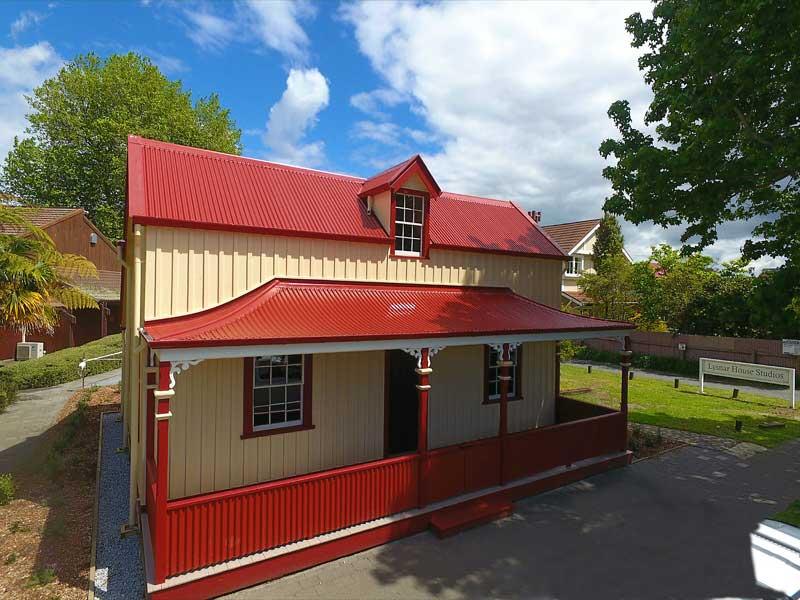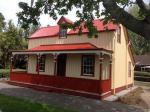Wyllie Cottage, Gisborne

As the first colonial home built on the northern side of the Taruheru River, Wyllie Cottage holds a special place in the history of Gisborne.
The city’s oldest surviving European house, Wyllie Cottage is thought to have been either built on the riverside site or moved there between 1871 and 1874.
Most likely built by John Forbes for James Ralston Wyllie and his wife, Kate, of Maori descent on her mother’s side and a daughter of one of Poverty Bay’s earliest settlers. It faced across the river towards the centre of Gisborne, a small settlement at the time.
Some 12 to 15 years later, it was moved about 50 metres and re-oriented to face Stout Street, where it sits today, alongside the Tairawhiti Museum, where it has been used as an exhibition space to give an insight into colonial times.
It was continuously occupied between 1886 and the 1970s, mainly as a tenanted cottage but also it served as an early schoolhouse. In the 1970s it faced demolition but the local community rallied around to save it and have it refurbished.
It was then fitted out as a cottage museum and served that purpose up until last year when it again required repairs and restoration so it could continue as a public display space. The cottage is one and a half storeys and is built predominantly of Kauri framework, beaded tongue and groove vertical boards and battens, and beaded tongue and groove kauri interior linings and kauri floors and stair treads. It has an outshot or lean-to added to the back of it with skillion roof that is thought to have been added as soon as the main building was erected, to meet the requirements of a large family.
Over the years Wyllie Cottage has been modified and ‘modernised’, making for a challenging restoration project, which was overseen by conservation architects Salmond Reed.
Salmond Reed’s Conservation Building Surveyor Tracey Hartley prepared a conservation plan for the cottage to return it to the condition it was in after it was moved in the late 1880s to the Stout Street site. She also took the opportunity to repair its many defects.
Work included new corrugate roofing and the reinstatement of the swept verandah roof. Joinery repairs have been undertaken to the exterior weatherboards, and windows that had been installed in the 1970s have been replaced with more authentic windows in the style of the surviving 19th Century windows.
The chimney stack has been reduced in height well below the roof to remove the earthquake risk that this imposed on the structure.
And the building has been painted in an historically accurate decorative scheme internally and externally.
When it came to the roofing, Tracey Hartley says they opted for a True Oak profile with heavy lead flashings for a traditional look. She says, “The original cottage on the earlier site nearby, at the bottom of the section, had a shingle roof. When the building was moved 12 to 15 years later that roof was probably in poor condition because it was covered over with a corrugated iron roof immediately. So it always had a corrugated roof on the Stout Street site.
“In the 1970s when it was ‘restored’ they decided to put shingles on. These failed within a short period and were not suited to the altered verandah because of the low pitch. Our analysis concluded that the roof should be corrugated steel as always intended for the site and a swept verandah roof - not the shingled one.”
Local firm Tony File Roofing, which had put on the shingle roof about 15 years ago, was employed to execute the job. While the cottage is small, some details were complex, Tony File says “Because one of the original roofs was traditional galvanised steel corrugate with heavy lead flashings - 25kg/m2 lead as opposed to the normal 17kg/m2 - we had to produce a special run of galvanised steel coil that was colour coated double-sided in Pioneer Red – with two months lead time - because you can’t use lead with a ZINCALUME® substrate”.
“Because of the concaved (exposed) front veranda roof and veranda balustrade cladding, this coil was specified to be double-sided colour coated as well.”
He adds, “The small flat roof to the back porch, the spouting (continuous Old Gothic in 125mm and 150mm sizes, and the downpipes (63mm and 75mm) were manufactured by B.J. Moss Ltd from pre-weathered quartz zinc, supplied by Wakefield Metals.”
“All the pre-weathered quartz zinc was specified to be soldered so we engaged the services of an experienced craftsman who still remembered and could execute the art of making, cutting angles and soldering together complicated downpipes.
Craftsman plumber Bruce Ledger, of local firm B.J. Moss Ltd, took on the soldering job.
As Roger Moss says, “That was originally how it was done. Put it this way, there was no silicone used on the job. And there was a bit of work involved with the soldering itself and then afterwards you have to clean it all down to get the quartz off it and wire brush it.”
The spouting and downpipes, which had handmade stainless brackets, were post-painted.
Tony File says the material for the flashings – made by B.J. Moss Ltd – was also double-sided galvanised steel in ‘Pioneer Red’.
Bothwell Construction repaired parts of the structure affected by rot and with the help of Awapuni Joinery reinstated fretwork, mouldings, windows and doors.
Tracey Hartley says choosing a colour scheme for the exterior of the cottage was also a challenge.
“There are only black and white photos available of the period we were restoring to, but they show clearly the three ‘tones’ of the decorative scheme, which we have followed even to the painting of the mouldings on the posts a different tone.
“Windows (opening parts) were nearly always painted an off-white in this period, the walling material was usually a mid-tone and the darker tone used for the trim, surrounds, barges etc. There were fewer pigments available in 1896, and these would have produced creams, browns, reds, greens; a very limited palette.
“The boards were investigated and evidence of dark cream was found. The doors had been removed and so are not original, but mostly doors were brown. The surrounds, trim etc – we chose as a traditional red, but it equally could have been a brown. So all we can say is that the cream and brown and off-white are accurate – the red is likely or probable – given other examples elsewhere that have been found.”
The resultant colour scheme has the windows ‘Off White’, surrounds in ‘Red Ember’, doors in ‘Brown’, and the boards and battens in ‘Cream’ using
predominantly linseed-based paint, which Tracey says is better for the health of the timber than modern acrylic paint and has a traditional matt look.
While trying to reinstate the cottage’s traditional look, work was also done on bringing the electrics and fire safety systems up to modern standard so that the building is protected for the long-term.
Wyllie Cottage is expected to re-open in the near future with new displays





